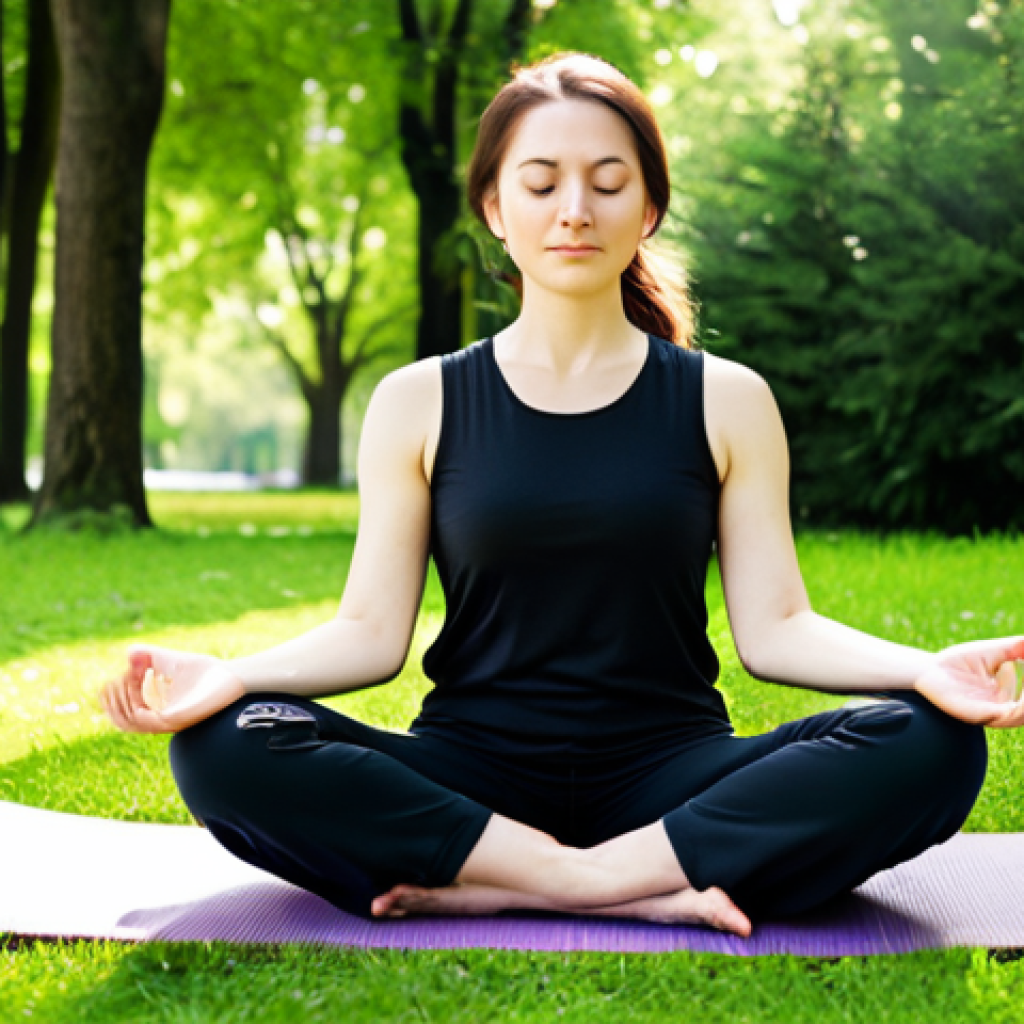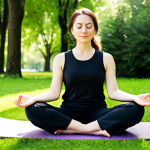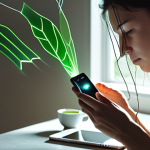Ever feel that nagging hum of your phone, even when it’s silent? I know I do. In this hyper-connected world, where our screens demand constant attention, it’s easy to feel utterly overwhelmed, like we’re drowning in notifications and endless content.
We’re living in an era where digital burnout is a real threat, and the antidote might just be simpler than we think. Rediscovering the quiet solace of nature and the centering power of meditation isn’t just a trend; it’s becoming a vital lifeline for our collective well-being.
Let’s dive deeper below. It feels like just yesterday we were marveling at smartphones, and now they’re almost a part of us, constantly pulling our focus.
I’ve personally found myself scrolling aimlessly for hours, only to feel more drained, not less. This isn’t just a personal anecdote; major tech companies are now even exploring features to help users manage screen time, acknowledging the growing mental health crisis fueled by always-on digital engagement.
The future isn’t about ditching tech entirely, but intelligently integrating periods of true disconnection. Think about it: could regular digital detoxes become as commonplace as gym memberships, a non-negotiable for mental fitness?
I truly believe so. By intentionally stepping back, even for short bursts, and reconnecting with the tangible world—a walk in a local park, a few minutes of quiet breathing—we can reclaim our attention spans and truly rejuvenate our minds.
This isn’t about Luddism; it’s about balance and sustainable living in a digitally saturated world. We’re at a pivotal point, recognizing that our digital habits deeply impact our emotional and physical landscapes.
Embracing nature and meditation offers a powerful counter-narrative to the relentless demands of the online sphere, allowing us to reset and thrive. This isn’t just a lifestyle choice; it’s becoming an essential survival strategy for modern sanity.
Ever feel that nagging hum of your phone, even when it’s silent? I know I do. In this hyper-connected world, where our screens demand constant attention, it’s easy to feel utterly overwhelmed, like we’re drowning in notifications and endless content.
We’re living in an era where digital burnout is a real threat, and the antidote might just be simpler than we think. Rediscovering the quiet solace of nature and the centering power of meditation isn’t just a trend; it’s becoming a vital lifeline for our collective well-being.
Let’s dive deeper below. It feels like just yesterday we were marveling at smartphones, and now they’re almost a part of us, constantly pulling our focus.
I’ve personally found myself scrolling aimlessly for hours, only to feel more drained, not less. This isn’t just a personal anecdote; major tech companies are now even exploring features to help users manage screen time, acknowledging the growing mental health crisis fueled by always-on digital engagement.
The future isn’t about ditching tech entirely, but intelligently integrating periods of true disconnection. Think about it: could regular digital detoxes become as commonplace as gym memberships, a non-negotiable for mental fitness?
I truly believe so. By intentionally stepping back, even for short bursts, and reconnecting with the tangible world—a walk in a local park, a few minutes of quiet breathing—we can reclaim our attention spans and truly rejuvenate our minds.
This isn’t about Luddism; it’s about balance and sustainable living in a digitally saturated world. We’re at a pivotal point, recognizing that our digital habits deeply impact our emotional and physical landscapes.
Embracing nature and meditation offers a powerful counter-narrative to the relentless demands of the online sphere, allowing us to reset and thrive. This isn’t just a lifestyle choice; it’s becoming an essential survival strategy for modern sanity.
Unraveling the Persistent Grip of Digital Overload

It’s not just a feeling; our brains are genuinely struggling to keep up with the relentless pace of digital information. I remember a time, not so long ago, when checking emails was a once-a-day ritual. Now, it feels like a continuous stream of pings, alerts, and urgent requests. This constant ‘on-call’ state has reprogrammed our nervous systems, making it incredibly difficult to truly disengage. We’re wired to respond, to check, to compare, and that wiring is exhausting. The sheer volume of content we consume daily, from endless news feeds to perfectly curated social media timelines, creates a cognitive load that most of us aren’t equipped to handle sustainably. I’ve often felt this invisible leash pulling me back to my phone, even when I desperately wanted to focus on something else. It’s a pervasive sense of urgency that technology instills, an underlying anxiety that if we’re not constantly connected, we’re missing out. This isn’t just a personal failing; it’s a systemic issue, and recognizing its depth is the first crucial step towards regaining control.
1. The Subtle Symptoms of Screen Fatigue
You know that fuzzy feeling behind your eyes after hours in front of a screen? Or the restless sleep you get because your mind is still buzzing with the day’s digital input? These aren’t just minor inconveniences; they’re genuine cries for help from your body and mind. I’ve personally experienced the cycle of hitting refresh endlessly, feeling more agitated with each scroll, rather than more informed or entertained. Headaches, irritability, a shortened attention span – these are the silent signals of digital exhaustion. It’s like our mental batteries are constantly being drained without adequate recharge time. And what about the impact on our vision? My optometrist recently recommended the 20-20-20 rule – every 20 minutes, look at something 20 feet away for 20 seconds. It sounds simple, but it’s a direct response to the strain our eyes endure from prolonged screen exposure. It’s a wake-up call to acknowledge that our digital habits are not benign; they have tangible, physical consequences that we often brush aside.
2. The Illusion of Constant Connection
We often tell ourselves that being constantly connected makes us more productive, more informed, or even more social. But does it truly? In my experience, the opposite often holds true. I’ve found myself ‘connected’ to hundreds, even thousands, of people online, yet feeling more isolated in real life. The quality of interaction often diminishes when it’s mediated by a screen. We trade deep, meaningful conversations for fleeting likes and surface-level comments. This illusion of connection can be profoundly misleading, creating a false sense of belonging while eroding the very real relationships that sustain us. It’s a stark reminder that while technology offers unparalleled reach, it can also inadvertently build walls if we don’t consciously nurture our offline bonds. True connection, I’ve learned, flourishes in shared spaces, in eye contact, in the unspoken language of presence – things no digital platform can fully replicate.
The Earth’s Embrace: Unplugging with Nature’s Therapy
Stepping out into nature isn’t just a pleasant pastime; it’s a profound act of self-care and a potent antidote to our digital woes. I remember feeling particularly frazzled one week, utterly buried under deadlines and notifications. My go-to wasn’t another podcast or a new series; it was a simple walk in my local park, just a few blocks from my apartment. As I felt the sun on my face and heard the rustle of leaves, I literally felt a physical shift – a loosening in my chest, a quieting of the incessant mental chatter. It’s a sensory feast that reawakens parts of our brains that digital screens put to sleep. The sounds of birdsong, the scent of damp earth after a rain, the intricate patterns of a leaf – these humble elements offer a grounding experience that technology simply cannot replicate. It’s a return to our primal roots, a reminder that before fiber optics and Wi-Fi, there was the wind, the trees, and the sky. This isn’t just anecdotal fluff; there’s a growing body of research, particularly in “forest bathing” (Shinrin-yoku) from Japan, that highlights nature’s ability to lower cortisol levels, improve mood, and even boost immunity. It’s an accessible, powerful therapy waiting right outside our doors, and it’s free.
1. Rediscovering Your Senses Outdoors
When was the last time you truly smelled the rain, felt the texture of tree bark, or saw the intricate details of a spiderweb glistening with dew? Our digital lives often dull our sensory perception, narrowing our world to the confines of a glowing rectangle. Nature, conversely, invites us to open up. I make it a point to engage all five senses when I’m outdoors. I listen intently to the myriad sounds – the distant chirping of crickets, the gentle murmur of a stream, the whispering of the wind through the branches. I take deep breaths, letting the fresh air fill my lungs, noticing the different scents carried on the breeze – pine, damp soil, blooming flowers. I run my hand over rough rocks and smooth leaves. This deliberate sensory engagement pulls me into the present moment, anchoring me away from the digital distractions that constantly vie for my attention. It’s like hitting a reset button for my entire being, allowing me to fully experience the richness of the tangible world around me. This simple practice has been transformative for my mental clarity and overall sense of peace.
2. Green Spaces as Mental Sanctuaries
Whether it’s a sprawling national park or a tiny urban green patch, these spaces are more than just pretty scenery; they are vital mental sanctuaries. For me, a short walk through a tree-lined street can be as effective as a longer hike in terms of mental refreshment. The presence of natural elements, even just a few potted plants on a balcony, has been shown to reduce stress and improve cognitive function. There’s something inherently calming about the color green, the irregular patterns of growth, and the quiet resilience of plant life. It’s a stark contrast to the rigid, predictable, and often overwhelming grid of our digital interfaces. These green havens provide a psychological break, a chance for our minds to wander freely without the constant demand for interaction or information processing. They allow us to breathe, to simply *be*, without an agenda, which is an increasingly rare and precious commodity in our hyper-scheduled lives. I’ve found that even 15-20 minutes in a green space can completely shift my perspective and re-energize me for the rest of the day.
Cultivating Inner Peace Through Mindful Presence
Meditation, often shrouded in a veil of mystique, is at its core a simple, powerful practice of mindful presence. It’s not about emptying your mind or achieving some profound spiritual enlightenment (though those can be side effects!), but rather about observing your thoughts and feelings without judgment. I started my meditation journey with just five minutes a day, using a simple guided app. At first, it felt awkward, my mind racing in a million directions. But with consistent practice, I began to notice subtle shifts: a greater sense of calm in stressful situations, an improved ability to focus, and a clearer understanding of my own emotional landscape. It’s like learning to ride a bike; initially wobbly, but with persistence, you find your balance. In a world that constantly bombards us with external stimuli, meditation teaches us to look inward, to find a stable anchor within ourselves. It’s a discipline that empowers us to choose our responses rather than react impulsively, which is a game-changer when navigating the often-overwhelming digital currents. For me, it has become a non-negotiable part of my daily routine, a dedicated moment to pause and reconnect with my authentic self.
1. Simple Entry Points to Mindful Living
You don’t need a meditation cushion or a silent monastery to start. Mindful living can be woven into the fabric of your everyday life. Try mindful eating: truly savoring each bite of your meal, noticing the textures and flavors, rather than scrolling through your phone while you eat. Or mindful walking: paying attention to the sensation of your feet on the ground, the rhythm of your breath, and the sights and sounds around you. One of my favorite simple practices is a ‘body scan’ before bed, where I systematically bring awareness to each part of my body, noticing any tension and inviting relaxation. These aren’t complex techniques, but they are incredibly effective at bringing your attention back to the present moment, away from the digital noise. The key is consistency, even if it’s just for a few minutes each day. It’s about building a muscle of awareness, one small, intentional moment at a time. I found that starting small made it feel less daunting and more achievable, leading to a much more sustainable practice.
2. The Science of a Quieter Mind
Beyond the subjective feelings of calm, science backs up the transformative power of meditation. Neuroimaging studies have shown that regular meditation can actually change the physical structure of the brain, increasing gray matter in areas associated with learning, memory, and emotion regulation, while decreasing the size of the amygdala, the brain’s “fear center.” This explains why I, and countless others, feel less reactive and more resilient after consistent practice. The brain’s ability to rewire itself, known as neuroplasticity, is incredible, and meditation is a direct way to encourage positive changes. It’s not magic; it’s a mental workout that strengthens your ability to concentrate, manage stress, and even cultivate compassion. Understanding the ‘why’ behind the ‘what’ has certainly motivated me to stick with it, knowing that each mindful breath isn’t just a moment of peace, but a building block for a healthier, more adaptable brain.
Designing Your Personal Digital Well-being Blueprint
True digital well-being isn’t about shunning technology altogether; it’s about intentionality. It’s about designing a personal blueprint that respects your relationship with screens, rather than letting screens dictate your life. I’ve experimented with various strategies over the years, and what I’ve learned is that one size absolutely does not fit all. What works for a friend might not work for you, and that’s perfectly okay. The goal is to find your own sustainable rhythm, a balance that feels genuinely freeing, not restrictive. This involves honest self-assessment – where are you spending your time online? How does it make you feel? What are your triggers for endless scrolling? Once you have that clarity, you can start building boundaries that serve your well-being. It’s a journey of continuous adjustment, much like setting up a smart home – you optimize for comfort and efficiency, not for constant overload. I’ve found immense peace in setting specific ‘no-phone zones’ in my home, like the bedroom or the dinner table, which has dramatically improved my sleep and my family interactions.
1. Implementing Smart Screen Time Boundaries
Setting boundaries can feel like a chore at first, but think of it as an act of self-love. I started by using my phone’s built-in screen time trackers. Seeing the raw data – those shocking hours spent on social media or news apps – was a powerful motivator. Then I implemented specific rules:
- No phone within an hour of waking up or an hour before bed. This significantly improved my morning clarity and sleep quality.
- Designated ‘unplugged hours’ in the evening, where my phone goes on silent in another room.
- Turning off non-essential notifications for most apps. I realized I don’t need an instant alert for every ‘like’ or marketing email.
These aren’t rigid rules carved in stone, but flexible guidelines that help me stay accountable. It’s about creating friction for mindless scrolling and ease for intentional engagement. For instance, I moved distracting apps off my home screen, making them harder to access. This small change made a huge difference in breaking the automatic ‘tap and scroll’ habit.
2. Curating Your Digital Environment
Just as you might declutter your physical living space, it’s essential to declutter your digital environment. My phone and laptop used to be chaotic landscapes of unread emails, endless apps, and overflowing photo galleries. This digital mess contributed to my mental clutter. I decided to treat my digital spaces like my physical ones:
- Unfollow accounts that make me feel bad or trigger comparison.
- Unsubscribe from newsletters I never read.
- Delete apps I haven’t used in months.
- Organize files and photos regularly.
This proactive curation makes my online interactions more intentional and less overwhelming. I aim for digital minimalism, keeping only what truly serves a purpose or brings me joy. It’s surprising how much mental bandwidth this frees up, allowing me to engage with content that genuinely enriches my life rather than just fills time. It’s a continuous process, but the payoff in mental clarity is absolutely worth it.
Navigating the FOMO Trap: Embracing the Joys of Disconnection
Ah, FOMO – the Fear Of Missing Out. It’s a powerful undercurrent in our hyper-connected lives, driving us to constantly check our feeds, worrying that something exciting, important, or entertaining is happening without us. I’ve definitely felt its icy grip, especially when friends post about a cool event I couldn’t attend, or a major news story breaks. It creates this nagging feeling that the world is moving on and I’m being left behind. But what I’ve slowly come to realize, through intentional periods of disconnection, is that often, what we’re truly missing out on is our own present moment, our own thoughts, our own real-life interactions. The ‘fear’ is often an illusion, a cleverly constructed narrative by algorithms designed to keep us engaged. Breaking free from this trap requires a conscious shift in perspective, recognizing that true richness in life comes from experience, not observation through a screen. It’s about choosing to be present in your own life, rather than constantly living vicariously through others’ curated highlights. It’s a profound feeling of liberation once you realize that the most important ‘things’ aren’t online.
1. Shifting Your Perception of ‘Being Present’
For too long, I equated being present with being available – constantly checking my phone, responding to messages immediately. But I’ve learned that true presence is about being fully engaged in your current reality. When I’m having coffee with a friend, I now consciously put my phone away and focus entirely on our conversation, the expressions on their face, the nuances of their voice. When I’m cooking, I pay attention to the aroma of the spices, the sizzle of the pan, the textures of the ingredients. It’s a deliberate reorientation of attention from the digital world to the tangible one. This shift has not only deepened my real-life connections but also made everyday activities far more enjoyable and fulfilling. It’s about recognizing that every moment holds potential for richness if we are truly there to experience it, rather than being half-present while our minds are elsewhere, scrolling through a digital feed. It’s about savoring life in real-time, not just documenting it for later.
2. Finding Joy in the Quiet Unseen Moments
The online world celebrates the spectacular, the shareable, the viral. But real life, the truly meaningful bits, often happen in the quiet, un-photographed moments. The sunrise you watch without feeling the need to post it. The book you read in peace, without distractions. The deep conversation you have with a loved one, away from prying eyes. These are the moments that build genuine happiness and inner peace, yet they often go unnoticed if we’re always looking for the next ‘shareable’ experience. Embracing disconnection means making space for these ‘unseen’ joys. It’s about finding contentment in the mundane, beauty in the ordinary, and peace in the solitude. I’ve started actively seeking out these moments, whether it’s simply sitting in my garden with a cup of tea, watching the clouds, or taking a long, unhurried walk with my dog. It’s in these pockets of quiet presence that I feel most alive and truly connected, not to a network, but to myself and the world around me.
The Unexpected Ripple Effects of Intentional Unplugging
The benefits of intentionally stepping back from the digital world extend far beyond simply reducing screen time. I’ve personally experienced a cascade of positive changes that I honestly hadn’t anticipated when I first embarked on this journey. It’s like clearing out a cluttered room; suddenly, you have space for new things, new thoughts, new experiences. My creativity, for one, has soared. Without the constant influx of external information, my own ideas have more room to bubble up and develop. I’ve found myself picking up old hobbies, like painting and playing guitar, that I’d neglected for years, simply because I now have the mental bandwidth and unstructured time to pursue them. Moreover, my ability to focus for extended periods has dramatically improved. I can read a book for hours without feeling the urge to check my phone, and my work sessions are much more productive. This isn’t just about feeling ‘less bad’; it’s about actively cultivating a ‘more good’ life, enriching it with genuine connection, deeper thought, and renewed passion. The ripple effect is truly transformative, touching every aspect of my daily existence.
1. Boosting Creativity and Cognitive Clarity
When our brains are constantly processing new information, notifications, and social feeds, they’re in a state of perpetual reactivity. This leaves little room for the kind of deep, imaginative thought that fuels creativity. I used to feel mentally sluggish, even when I wasn’t doing anything demanding. Now, after consistent digital breaks, it’s as if a fog has lifted. My mind feels sharper, ideas flow more freely, and I can connect disparate concepts with greater ease. This isn’t a coincidence; studies show that prolonged screen time, especially passive consumption, can hinder our brain’s ability to engage in ‘default mode network’ activity – the state where creative insights often arise. By unplugging, we allow our minds to wander, to make new connections, and to process information in a more profound way. It’s a return to organic thought, unburdened by external stimuli, and it’s a powerful catalyst for innovative thinking and problem-solving.
2. Enhancing Real-World Relationships
One of the most heartwarming ripple effects I’ve noticed is the profound improvement in my real-world relationships. When I’m truly present with my friends and family, without the constant distraction of a buzzing phone, our conversations are deeper, more authentic, and far more fulfilling. I make eye contact, I listen actively, and I engage fully. My partner and I have implemented ‘phone-free’ evenings, where we simply talk, play board games, or cook together. These moments have strengthened our bond immensely, reminding us of the joy of undivided attention. It’s a stark contrast to those dinners where everyone is staring at their screens, physically together but mentally miles apart. By disengaging from the digital world, we create space for genuine human connection, fostering empathy, understanding, and shared experiences that truly enrich our lives. The best connections, after all, are built face-to-face, heart-to-heart, not screen-to-screen.
Cultivating a Sustainable Rhythm for Modern Living
Finding a sustainable rhythm in our digitally saturated world is perhaps the most challenging yet rewarding aspect of this journey. It’s not about achieving perfection overnight, but about consistently making choices that prioritize our well-being over constant connectivity. I’ve learned that consistency, even in small doses, is far more impactful than drastic, unsustainable measures. A five-minute mindful breathing exercise daily is more beneficial than an hour-long session once a month. A short walk in the park three times a week builds more resilience than an infrequent intense hike. The goal is to weave these practices into the fabric of your everyday life, making them as natural as brushing your teeth or making your morning coffee. This means being kind to yourself when you slip up – because you will – and gently guiding yourself back on track. It’s about building habits that support your long-term mental and emotional health, creating a personal operating system that allows you to thrive amidst the demands of modern life, rather than merely survive them. It’s a marathon, not a sprint, and every small step forward counts.
1. Incremental Steps for Lasting Change
Trying to overhaul all your digital habits at once can feel overwhelming and often leads to quick burnout. My approach has always been about small, manageable steps. Start with one ‘no-phone zone’ in your home. Then try leaving your phone in another room for just an hour each evening. Gradually, you can build on these small successes. I found it helpful to replace old habits with new ones. Instead of scrolling social media before bed, I started reading a physical book. Instead of checking emails first thing in the morning, I started a five-minute stretching routine. These incremental changes accumulate over time, creating a powerful shift in your daily routine without feeling like a major deprivation. It’s about mindful substitution, building positive new pathways in your brain, and proving to yourself that you can indeed live a fulfilling life with less screen time. Consistency, however small, is the secret sauce for sustained well-being in the digital age.
2. Measuring Your Own Well-being Metrics
How do you know if your efforts are making a difference? Beyond just tracking screen time, I encourage you to pay attention to your personal well-being metrics. How do you feel when you wake up? How’s your mood throughout the day? Are you sleeping better? Do you feel more present in conversations? These subjective measures are often more telling than any app statistic. I keep a simple journal where I jot down how I feel at the end of each day, noting any patterns related to my digital use. For example, if I had a particularly good night’s sleep, I might note that I had my phone off for two hours before bed. If I felt unusually stressed, I might reflect on whether I spent too much time on news sites. This self-awareness empowers you to fine-tune your blueprint, ensuring that your digital habits genuinely support your overall health and happiness. It’s a personalized feedback loop, helping you to understand what truly nourishes your mind and spirit.
| Aspect of Well-being | Impact of Excessive Digital Use | Benefit of Intentional Disconnection & Nature/Meditation |
|---|---|---|
| Mental Clarity & Focus | Fragmented attention, increased brain fog, reduced deep work capacity. | Improved concentration, enhanced problem-solving, reduced mental clutter. |
| Emotional Regulation | Increased anxiety, irritability, comparison-induced sadness (FOMO). | Greater emotional resilience, decreased stress, enhanced feelings of calm. |
| Physical Health | Eye strain, poor posture, disrupted sleep patterns, sedentary lifestyle. | Better sleep quality, increased physical activity, reduced headaches. |
| Social Connection | Surface-level online interactions, real-life isolation, decreased empathy. | Deeper, more authentic in-person relationships, improved communication. |
| Creativity & Purpose | Reduced spontaneous thought, less time for hobbies, feeling uninspired. | Boosted creativity, renewed passion for interests, clearer sense of purpose. |
Embracing the Unplugged Future: A Path to Genuine Connection
The future of our relationship with technology isn’t about rejection; it’s about re-evaluation and intentional integration. We’re at a fascinating crossroads where the very tools that connect us globally are simultaneously prompting a deep yearning for local, tangible connection. For me, this journey of intentional unplugging has been less about giving things up and more about gaining so much more. I’ve gained back hours in my day, moments of genuine presence, deeper conversations with loved ones, and a renewed sense of self that felt buried under a mountain of notifications. It’s about recognizing that our greatest asset is our attention, and we have the power to choose where we direct it. When we consciously opt for a walk in the park over endless scrolling, or a few minutes of quiet reflection over checking one last email, we are not just making a small personal choice; we are participating in a larger movement towards a more humane and balanced way of living in the digital age. This isn’t a luxury; it’s becoming a necessity for anyone who wants to truly thrive, not just survive, in this hyper-connected world. It’s about building a life rich in real experiences, not just digital ones.
1. The Joy of True Presence in Everyday Life
There’s an undeniable joy that comes from being truly, fully present in a moment, without the pull of a screen or the urge to document it for others. I’ve found it in the simple act of watching my cat chase a sunbeam, or listening intently to the unique sound of rain hitting my window. These are the micro-moments of pure, unadulterated presence that often get overlooked when our minds are constantly elsewhere, anticipating the next notification or planning the next post. When you remove the digital filter, the world around you suddenly becomes more vibrant, more textured, more alive. It’s about experiencing life as it unfolds, in high definition, rather than through the lens of a smartphone camera. This doesn’t mean never taking a photo again, but it does mean choosing to prioritize the experience itself over its digital capture. This shift has brought a profound sense of peace and contentment into my life, grounding me in the richness of the now.
2. Inspiring Others Through Intentional Living
My journey into digital well-being and mindful living started as a deeply personal quest, but I’ve been amazed by how often it sparks conversations with others. When people see me genuinely engaged in a conversation without my phone out, or hear about my phone-free evenings, it often prompts them to reflect on their own habits. It’s not about preaching or judging; it’s about sharing an alternative way of living that prioritizes presence and well-being. I’ve seen friends implement their own ‘digital sundowns’ or start daily walks in nature, inspired by how much calmer and happier I seem. This ripple effect is incredibly powerful. By simply living more intentionally, we can become quiet advocates for a more balanced relationship with technology, inspiring those around us to explore their own path to genuine connection and inner peace. It’s a testament to the idea that positive change often starts with one individual bravely choosing a different, more fulfilling path.
Wrapping Up
As we navigate this intricate dance between our digital lives and our innate need for balance, remember that the power to choose how you engage truly rests with you. My journey has shown me that intentionally embracing nature and mindful moments isn’t about escaping reality; it’s about enriching it, deepening our connections, and reclaiming our most precious resource: our attention. It’s a continuous, evolving process, but every small step towards a more balanced digital life is a step towards a more peaceful, present, and authentically joyful you. You have the power to curate a life where technology serves you, rather than the other way around. Go on, unplug, and rediscover the vibrant world waiting just beyond your screen.
Useful Information to Know
1. Mindfulness & Meditation Apps: If you’re new to meditation, apps like Calm, Headspace, and Ten Percent Happier offer guided meditations for all levels. They make it easy to start with just 5-10 minutes a day, introducing you to foundational practices that can significantly reduce stress and improve focus.
2. Finding Green Spaces: Utilize online maps like Google Maps or local park finder websites to locate nearby parks, nature trails, or even community gardens. Even a small patch of green can offer a valuable respite from urban noise and digital demands.
3. Digital Well-being Features: Most smartphones (both iOS and Android) have built-in “Screen Time” or “Digital Wellbeing” features. Use these to track your app usage, set app limits, schedule downtime, and turn off non-essential notifications. Seeing your data can be a powerful motivator for change.
4. Recommended Reading: Dive deeper into the topic with books like “Digital Minimalism” by Cal Newport, “Frazzled” by Ruby Wax (on mindfulness), or “Your Brain on Nature” by Eva M. Selhub and Alan C. Logan. These offer scientific insights and practical strategies for a healthier digital-life balance.
5. The 20-20-20 Rule for Eye Health: To combat digital eye strain, every 20 minutes, look at something 20 feet away for 20 seconds. This simple practice gives your eyes a much-needed break from focusing on a close-up screen and helps prevent fatigue and dryness.
Key Takeaways
Digital overload is a real threat to mental and physical well-being. Intentional disconnection, paired with engagement in nature and mindful meditation, provides a powerful antidote. Setting smart boundaries, curating your digital environment, and embracing true presence can significantly enhance mental clarity, emotional regulation, and real-world relationships. This isn’t about shunning technology but about cultivating a sustainable, balanced rhythm for modern living, leading to a more fulfilling and authentically connected life.
Frequently Asked Questions (FAQ) 📖
Q: How can I realistically start a digital detox when my life feels so intertwined with technology, and I just can’t seem to break away?
A: Oh, believe me, I’ve been there, feeling absolutely glued to my phone, even when I knew it was making me miserable. The trick isn’t to suddenly become a hermit; it’s about micro-doses of disconnection.
I found what really helped was setting super small, non-negotiable windows. Like, “Okay, from 7 PM to 8 PM, my phone is physically out of reach, maybe in a drawer in the kitchen.” Or, “No phone at the dinner table, ever.” It felt awkward at first, almost like I was missing a limb, but those little gaps of quiet started to feel… liberating.
Seriously, just five minutes of conscious breathing or a quick walk around the block, leaving the phone behind, can make a surprising difference. You’re not aiming for perfection; you’re just gently, intentionally, creating some space between you and the endless digital hum.
It’s like training a muscle; you start small, and over time, you build up your capacity for calm.
Q: You talked about digital burnout being a “real threat” and a “survival strategy.” How serious is this issue, and what tangible, personal benefits have you actually experienced from embracing these practices?
A: It’s way more serious than we often let on, isn’t it? That constant low-level anxiety, the feeling of never quite catching up, the exhaustion from always being “on”—that’s burnout knocking.
I used to just chalk it up to being busy, but it was really chipping away at my focus, my sleep, even my ability to just enjoy a quiet moment with my family.
When I started truly committing to these “digital breaks” and a bit of mindful presence, the changes were profound. For one, my sleep drastically improved; I wasn’t falling asleep to a glowing screen anymore.
My attention span, which felt like it had been shredded into confetti, actually started to knit itself back together. I could read a book, hold a conversation without my mind wandering, and even enjoy simple things like gardening or just watching the clouds.
It’s not some magic cure, but it’s like rediscovering your own mind, your own true self, beneath all the digital noise. The clarity, the peace, the genuine presence—those are the real, undeniable returns on this investment in myself.
Q: Is this really about completely ditching technology, or is there a way to find a balance, especially when so much of our work and social lives rely on being online?
A: Absolutely not about ditching it entirely! I mean, who could actually do that in this day and age? My work depends on technology, and honestly, a lot of my social connections are nurtured online too.
The key isn’t Luddism; it’s about intentionality and balance. Think of it like a healthy diet—you don’t eliminate all carbs or fats, but you choose when and how much you consume.
For me, it’s about creating boundaries, like setting specific “work hours” for email and social media, rather than letting them bleed into every waking moment.
I’ve also found immense benefit in “batching” my online time, getting everything done in a focused burst rather than constantly checking. It’s about being the master of your tech, not its slave.
The goal is to integrate periods of genuine, refreshing disconnection into a life that still, very much, includes the digital. It’s a skill, really, learning to navigate this hybrid world gracefully, so you can harness the good parts of tech without letting it overwhelm your well-being.
📚 References
Wikipedia Encyclopedia
구글 검색 결과
구글 검색 결과
구글 검색 결과
구글 검색 결과
구글 검색 결과






